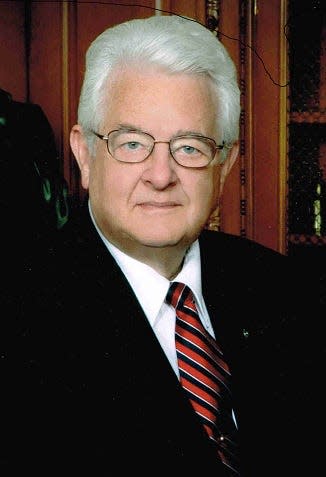Shelburne faith column: “O Come, All Ye Faithful!”
- Oops!Something went wrong.Please try again later.
Although it has always been one of my favorite Christmas carols, I was shocked by some of the unexpected details Benjamin Ivry shares in his historical review of “Adeste Fideles” (“O Come, All Ye Faithful”).
Worshipers at St. Peters in Rome will enjoy it again this year as they conclude their Midnight Mass on Christmas Eve, while non-Catholics worldwide will be singing the same carol in most of their Christmas celebrations. Few things have done more than this carol to unify all sorts of Christians around the globe.

Originally written in Latin (hence, its traditional name), the call, “O come, let us adore him,” Ivry says, will be used in liturgies by Christians of an amazing variety of stripes. Partly because some sections of the carol repeat the Nicene Creed.
Many scholars trace the music itself to a lay Catholic musician, John Frances Wade, who got kicked out of England after the Jacobite revolution. Some people in that setting heard the music in this now popular carol as a call for revolutionaries to return to London to restore Bonnie Prince Charles to the throne. That’s amazing. How many of us have ever heard a hint of patriotic content in it?
But musicologists fiddle with other ideas about its origin. One myth attributes the musical score to a 17th-century Portuguese king who was an amateur composer. But that is not why folks in England during one period called it “the Portuguese hymn.” In the anti-Catholic British world of the 1700s, they first had heard this “papist song” performed at Portugal’s embassy in London.
A century later, “Adeste Fideles” had become one of the most popular tunes in Scotland, whistled by apprentice boys on every street and, as one missionary described its popularity, even “the blackbirds in the square joined in the chorus!”
While the true source of the music may never be known, nothing has spiked this carol’s popularity more than the translation of its Latin words into English. Actually, though, its popularity has grown among people of almost all nationalities and languages.
Some amusing anecdotes are told about translation bloopers that occurred as the carol moved from tribe to tribe. But no matter where you are or what language you speak, one thing is universally true. Everybody thinks of Christmas when they hear these most-familiar notes calling us:
O come, let us adore Him.
Christ the Lord!
Gene Shelburne is pastor emeritus of the Anna Street Church of Christ, 2310 Anna Street, Amarillo, Texas. Contact him at GeneShel@aol.com, or get his books and magazines at www.christianappeal.com. His column has run on the Faith page for more than three decades.
This article originally appeared on Amarillo Globe-News: Shelburne faith column: “O Come, All Ye Faithful!”
